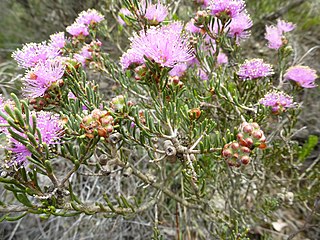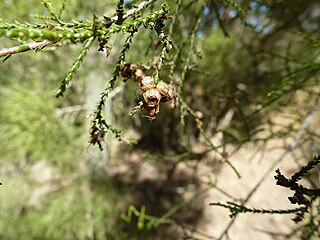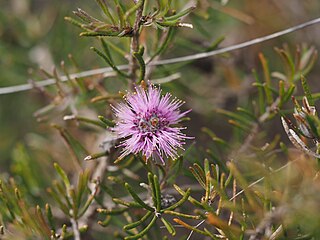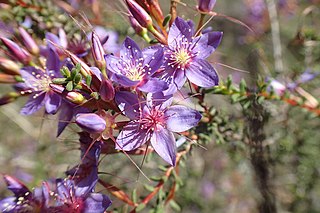
Calytrix is a genus of about 83 species of flowering plants, commonly known as star flowers, in the family Myrtaceae and is endemic to Australia. Plants in the genus Calytrix are small to large shrubs with small, spreading and more or less round leaves, the flowers arranged singly in leaf axils. The flowers are bisexual with 5 overlapping sepals with a long awn, and many stamens.

Melaleuca campanae is a plant in the myrtle family, Myrtaceae and is endemic to the south-west of Western Australia. It is a small, woody shrub similar to Melaleuca eulobata, with a low, spreading habit and pinkish flower heads but it has longer, pointed leaves and lacks distinct sepals which instead form a ring of tissue around the edge of the flowers.

Melaleuca carrii is a plant in the myrtle family, Myrtaceae and is endemic to the south-west of Western Australia. It is a small shrub similar to Melaleuca pentagona, with "pom-pom" heads of pinkish flowers and sharply pointed leaves but it is generally smaller, lacks a groove in its leaves and retains its petals on the flowers for longer than that species.

Melaleuca dempta is a plant in the myrtle family, Myrtaceae and is endemic to the south-west of Western Australia. It is an erect shrub resembling Melaleuca calycina with its heads of white flowers and egg-shaped to heart-shaped leaves. It was formerly considered a subspecies of Melaleuca calycina subsp. dempta but it lacks the star-like fruits of that species and its leaves have a blunt rather than a pointed tip.

Melaleuca eurystoma is a plant in the myrtle family, Myrtaceae and is endemic to the south of Western Australia. It is a small shrub with pale lemon to greenish flowers and egg-shaped to almost oval leaves.

Melaleuca glena is a plant in the myrtle family, Myrtaceae and is endemic to the south of Western Australia. It is similar to the commonly cultivated Melaleuca nesophila with its purple "pom-pom" flower heads but is a smaller shrub with the inflorescences much more often on the sides of the branches and only occasionally on the ends.

Melaleuca leuropoma is a plant in the myrtle family, Myrtaceae and is endemic to the south-west of Western Australia. It is a small to medium-sized shrub which flowers over an extended period with flower colour varying from purple to yellow or white. The glossy, often brown petals covering the flower buds are also an unusual characteristic of this species.

Melaleuca monantha is a plant in the myrtle family, Myrtaceae and is endemic to an area in Queensland, Australia. It is a shrub, similar to Melaleuca minutifolia with very small leaves but the leaves lack oil glands and its flowers occur singly, rather than in pairs. It is also similar to Melaleuca sylvana but is usually multi-stemmed and has a more dense crown than that species.

Melaleuca tinkeri is a plant in the myrtle family, Myrtaceae and is endemic to the south-west of Western Australia. It is one of the smallest melaleucas and is distinguished by its warty, hairy leaves, heads of pinkish flowers in late winter to spring and its spherical fruiting clusters.

Melaleuca violacea is a plant in the myrtle family Myrtaceae and is endemic to a small area in the south-west of Western Australia. It is a small, straggly, prostrate to semi-prostrate shrub with purple flowers and star-shaped fruit.

Melaleuca genialis is a plant in the myrtle family, Myrtaceae, and is endemic to the south-west of Western Australia. It is a rare species, known from one nature reserve. It is similar to Melaleuca tinkeri, mainly differing from it in having hairy leaves and petals.

Kunzea newbeyi is a flowering plant in the myrtle family, Myrtaceae and is endemic to a small area along the south coast of Western Australia. It is a robust shrub with small leaves and groups of about twenty to thirty pink flowers in October and November.

Calytrix achaeta, commonly known as the white-flowered turkey bush, kerosene wood or fringe-myrtle, is a species of flowering plant in the myrtle family Myrtaceae and is endemic to north-western Australia. It is a shrub or tree with hairy branchlets, egg-shaped, linear or lance-shaped leaves, and white to cream-coloured flowers with 12 to 18 stamens in a single row.

Calytrix acutifolia is a species of flowering plant in the myrtle family Myrtaceae and is endemic to south-west of Western Australia. It is a slender, openly-branched shrub with linear to lance-shaped leaves and clusters of white, cream-coloured or yellow flowers with 40 to 85 white stamens in several rows.

Calytrix angulata, commonly known as yellow starflower, is a species of flowering plant in the myrtle family Myrtaceae and is endemic to the south-west of Western Australia. It is a shrub with linear to egg-shaped leaves and clusters of yellowish-cream coloured flowers with 30 to 40 yellow stamens in several rows.

Calytrix exstipulata, commonly known as turkey bush, Kimberley heather, heather bush or pink fringe-myrtle, is a species of flowering plant in the myrtle family Myrtaceae and is endemic to northern Australia. It is an erect shrub with narrowly egg-shaped to elliptic leaves and clusters of dark red, pink and white flowers with mainly pink stamens.

Calytrix violacea is a species of flowering plant in the myrtle family, Myrtaceae and is endemic to the southwest of Western Australia. It is a shrub with linear to narrowly egg-shaped leaves with the narrower end towards the base, and purple, star-shaped flowers.
Calytrix merrelliana is a species of plant in the myrtle family Myrtaceae that is endemic to Western Australia.
Micromyrtus placoides is a species of the flowering plant in the family Myrtaceae and is endemic to the inland areas of Western Australia. It is a shrub with glabrous, oblong to almost round leaves, white flowers 3.0–3.5 mm (0.12–0.14 in) in diameter, and 10 stamens in each flower.

Calytrix alpestris, commonly known as snow-myrtle, is a species of flowering plant in the myrtle family Myrtaceae and is endemic to southern continental Australia. It is a shrub with wiry branchlets, linear to narrowly egg-shaped or narrowly lance-shaped leaves and clusters of white flowers with 14 to 37 white stamens in a single row.

















